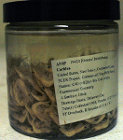Stream Survey Collections at the Academy of Natural Sciences of Philadelphia
Gary Rosenberg (page last updated 17 July 2009)Since 1948, staff of the Patrick Center for Environmental Research at the Academy of Natural Sciences of Philadelphia have surveyed the aquatic fauna and flora of more than 100 watersheds and estuaries, mostly in the eastern US, but also in Canada, Puerto Rico, and Peru. They used techniques pioneered by Academy scientist Dr. Ruth Patrick, for whom the Patrick Center is named.
 The surveys covered a broad range of taxa, including fish, diatoms, algae, sponges, flatworms, annelids, mollusks, crustaceans and
insects, and aimed to determine the health of aquatic ecosystems. Funding for the aquatic surveys came from corporations or agencies
interested in environmental impacts of various industrial practices, but did not provide for long term archival storage and curation
of the samples collected. Over the years, hundreds of thousands of specimens from the surveys were added to the Academy’s biological
specimen collections, but as of 2005, more than 80,000 samples of invertebrates, fish and algae remain unaccessioned.
The surveys covered a broad range of taxa, including fish, diatoms, algae, sponges, flatworms, annelids, mollusks, crustaceans and
insects, and aimed to determine the health of aquatic ecosystems. Funding for the aquatic surveys came from corporations or agencies
interested in environmental impacts of various industrial practices, but did not provide for long term archival storage and curation
of the samples collected. Over the years, hundreds of thousands of specimens from the surveys were added to the Academy’s biological
specimen collections, but as of 2005, more than 80,000 samples of invertebrates, fish and algae remain unaccessioned.
 With funding from the National Science Foundation, more than 60,000 of these samples have been rehoused in archival materials,
catalogued, geo-referenced and added to the Academy’s collections. An online database allows the stream survey collections to be
searched. These collections have substantial research value, providing a baseline for studies of environmental change in many
aquatic systems. The Savannah River in South Carolina and Georgia has been sampled almost annually since 1951, and the Delaware
(PA, NJ, DE), Flint (GA), Guadalupe (TX), Patuxent (MD), Potomac (MD), Sabine (TX), and Susquehanna (PA) rivers and Chesapeake Bay
have all been surveyed a dozen or more times.
With funding from the National Science Foundation, more than 60,000 of these samples have been rehoused in archival materials,
catalogued, geo-referenced and added to the Academy’s collections. An online database allows the stream survey collections to be
searched. These collections have substantial research value, providing a baseline for studies of environmental change in many
aquatic systems. The Savannah River in South Carolina and Georgia has been sampled almost annually since 1951, and the Delaware
(PA, NJ, DE), Flint (GA), Guadalupe (TX), Patuxent (MD), Potomac (MD), Sabine (TX), and Susquehanna (PA) rivers and Chesapeake Bay
have all been surveyed a dozen or more times.
 The time series of samples allow investigations of reasons for change, by means such as analysis of stable isotopes and
incorporated pollutants or detecting shifts in diet from stomach contents. The samples are also important for research in
systematics and biogeography. Genetic studies in recent years have shown that many supposedly cosmopolitan species are actually
species complexes. The catalogued samples serve as vouchers, allowing verification of the identifications Also, it should be
possible to extract DNA from survey samples, particularly those that were not treated with formalin (documented in the database).
The time series of samples allow investigations of reasons for change, by means such as analysis of stable isotopes and
incorporated pollutants or detecting shifts in diet from stomach contents. The samples are also important for research in
systematics and biogeography. Genetic studies in recent years have shown that many supposedly cosmopolitan species are actually
species complexes. The catalogued samples serve as vouchers, allowing verification of the identifications Also, it should be
possible to extract DNA from survey samples, particularly those that were not treated with formalin (documented in the database).
This material is based upon work supported by the National Science Foundation under DBI Grant No. 0448256. Any opinions, findings, and conclusions or recommendations expressed in this material are those of the author and do not necessarily reflect the views of the National Science Foundation.
